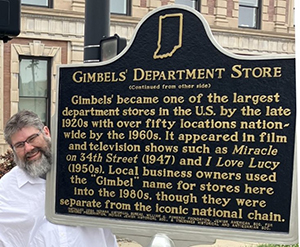By Jerry Klinger

VINCENNES, Indiana — Does Macy’s tell Gimbels?
The iconic and ironic American idiom gained international popularity from the 1947 Christmas movie Miracle on 34th Street. Iconic in that it came to mean keeping a secret. Ironic, the secret was that Macy’s and Gimbels both had Jewish roots. Both became giants of American Department store corporate history, transforming the American economy and retailing. Gimbels began the transformative process in Vincennes, Indiana.

The Gimbels Department Store Historical marker is funded by the Jewish American Society for Historic Preservation. The effort began nearly two years ago in response to a recommendation by Michael Brown, executive director of the Indiana Jewish Historical Society.
One hundred and seventy-seven years ago in 1848, Adam Gimbel opened up his first retail location on the corner that locals fondly still call Gimbels Corner.
Adam Gimbel started as a young Jewish peddler with a few notions and home items that he could carry on his back, walking up the Mississippi pathways from New Orleans. He sold his merchandise to remote and isolated settlers. By 1842, he had made his way as far north as the booming frontier town of Vincennes, near the confluence of the Wabash and Ohio Rivers. In one week, he sold everything.
Saving and reinvesting in his business, he was able to purchase a horse and wagon for his goods.
His ambition grew in a New World where being a Jew was secondary to what he could do. His reputation for honest, fair dealings and multilingual ability expanded his market. Common-sense business practices that were not so common-sense on the frontier. He settled in Vincennes and brought his family. Gimbel formally opened shop in 1848. Business boomed.
An anecdotal story about Gimbel. The Archbishop of Vincennes area came into Gimbels and placed a large bag of money on the counter without counting it or asking for a receipt. His only instruction to Adam was to apply it to the Church’s account.
When asked why the Archbishop would do such a naïve, trusting thing, the Archbishop responded. Adam Gimbel was an honest man.
“Fairness and equality of all patrons, whether they be residents of the city, plainsmen, traders, or Indians,” was Gimbel’s motto. Customers did not have to haggle over prices at Gimbels. They knew Gimbels’ one-price system was fair, and the merchandise was of good quality. They never felt cheated or disrespected.
In 1887, Gimbel relocated his center of operations to Milwaukee, a predominantly German immigrant community. Gimbel built his first mega-store. The store was tiny in comparison to the incredible anchor stores the Gimbels chain would build in just 20 years in Philadelphia and New York.
The New York anchor store, in Herald Square, just a few blocks from R.H. Macy’s anchor store, was a monster. Gimbels N.Y. had over 27 acres of retail space spread over ten stories. The average, cavernous Home Depot today is about 110,000 square feet. Gimbels was over 1,100,000 square feet, complete with restaurants, a 1,000-seat auditorium, and more. The marketing, the window displays, and the competitive American capitalist spirit made Gimbels an experience just to go to. And all the while, like Gimbel had begun in Vincennes, honest dealing, good merchandise at a good price, and treating every customer with respect and dignity were cornerstones to its success.
In the 1960s, Gimbels had over 50 locations nationwide. They shaped, they controlled, they directed American mass marketing and retail culture. Then the American retailing world changed.
Gimbels, no longer controlled by the Gimbel family, failed to catch the cultural changes going on in American retailing. By the 1980s, Gimbels was gone. Macy’s continued to survive as part of the corporate retailing conglomerates that took over. Macy’s days of hegemonic leadership were numbered.
Gimbels left its cultural mark on America. It was the first to understand the importance of programmatic name associations. Gimbels created the first Thanksgiving Parade experience in Philadelphia. The Gimbels Parade pre-dated the Macy’s Thanksgiving Day Parade. Over 500,000 people annually attended the early Gimbels Parade.
From marketing to media to cultural impacts, Gimbels helped transform America. Gimbels may have gone. The mark of the Jewish frontier Gimbels family on America endures.
The marker text:
“Bavarian Jewish immigrants Adam and Solomon Gimbel worked as peddlers before establishing a dry goods and clothing store here by 1848. Regular advertising and quality goods drew customers, and the business prospered. The company moved to Milwaukee in 1887, expanding to Philadelphia (1894) and New York City (1910). In the 1920s, Gimbels went public and acquired Saks and Co.
Gimbels became one of the largest department stores in the U.S. by the late 1920s with over fifty locations nationwide by the 1960s. It appeared in film and television shows such as Miracle on 34th Street (1947) and I Love Lucy (1950s). Local business owners used the “Gimbel” name for stores here into the 1980s, though they were separate from the iconic national chain.”
It was very fitting that the Gimbels’ marker was dedicated on May 16. It was Adam Gimbels’ birthday.
*
Jerry Klinger is the President of the Jewish American Society for Historic Preservation